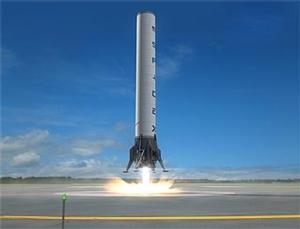Sat, Oct 01, 2011
Booster, Second Stage, Crew Or Cargo Capsule Would All See
Multiple Uses
SpaceX Founder Elon Musk outlined a fully re-usable commercial
space system Thursday in a speech that was webcast from the
National Press Club in Washington, DC and archived by C-SPAN.
SpaceX Animation Image

In a video SpaceX has placed on YouTube,
the company foresees a transportation system in which all
components can be recovered and re-used, including the booster and
second stages which would take the crew or cargo module to orbit.
In the video, animation shows both the first and second stages
being returned to their launch site at Cape Canaveral in Florida,
not falling back to Earth under parachutes into the ocean, but
descending on engine power to a precise, controlled landing on the
ground. The crew module returns to Earth in much the same way.
In his speech, Musk said up to now, the complexities of such a
system have kept it from being built, but that "probably in the
last 12 months or so, I've come to the conclusion that it can be
solved and I think SpaceX is going to try to solve it." He did say
that while the video was a fairly accurate representation of the
system, it does not give away any proprietary company secrets.
Musk said the company could fail in its effort, but if it is
successful, it could greatly reduce the cost of transporting people
and cargo to low Earth orbit. As an example, he said one of the
company's Falcon 9 rockets costs about $50 to $60 million, but that
the fuel for each launch is only about $200,000. He said using a
rocket, for instance, a thousand times, could reduce the effective
cost of each launch to only about $50,000.
SpaceX is scheduled to launch a Falcon 9 rocket with an unmanned
Dragon 9 capsule to the ISS in January. Musk said the current
problems with Russian Soyuz spacecraft have caused that projected
launch date to be pushed back from November to assure that the
correct personnel with the correct training can be on board when
the Dragon spacecraft arrives at ISS. The components of the Falcon
9 rocket are already designed to be re-usable following recovery
from the ocean.
SpaceX Animation Image

More News
Aero Linx: Model Aeronautical Association of Australia MAAA clubs are about fun flying, camaraderie and community. For over 75 years, the MAAA has been Australia’s largest fl>[...]
Touchdown Zone Lighting Two rows of transverse light bars located symmetrically about the runway centerline normally at 100 foot intervals. The basic system extends 3,000 feet alon>[...]
“Discovery and innovation are central to our mission at Virgin Galactic. We’re excited to build on our successful record of facilitating scientific experiments in subor>[...]
How To Get A Story On Aero-TV News/Feature Programming How do I submit a story idea or lead to Aero-TV? If you would like to submit a story idea or lead, please contact Jim Campbel>[...]
Student Pilot Reported That During Rotation, “All Of A Sudden The Back Of The Plane Kicked To The Right..." Analysis: The student pilot reported that during rotation, “>[...]
 ANN's Daily Aero-Linx (05.02.24)
ANN's Daily Aero-Linx (05.02.24) ANN's Daily Aero-Term (05.02.24): Touchdown Zone Lighting
ANN's Daily Aero-Term (05.02.24): Touchdown Zone Lighting Aero-News: Quote of the Day (05.02.24)
Aero-News: Quote of the Day (05.02.24) ANN FAQ: Contributing To Aero-TV
ANN FAQ: Contributing To Aero-TV NTSB Final Report: Cirrus Design Corp SR20
NTSB Final Report: Cirrus Design Corp SR20




